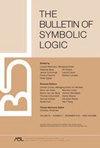Preservation of Structural Properties in intuitionistic Extensions of an Inference Relation
IF 1.1
3区 数学
Q1 LOGIC
引用次数: 2
Abstract
The article approaches cut elimination from a new angle. On the basis of an arbitrary inference relation among logically atomic formulae, an inference relation on a language possessing logical operators is defined by means of inductive clauses similar to the operator-introducing rules of a cut-free intuitionistic sequent calculus. The logical terminology of the richer language is not uniquely specified, but assumed to satisfy certain conditions of a general nature, allowing for, but not requiring, the existence of infinite conjunctions and disjunctions. We investigate to what extent structural properties of the given atomic relation are preserved through the extension to the full language. While closure under the Cut rule narrowly construed is not in general thus preserved, two properties jointly amounting to closure under the ordinary structural rules, including Cut, are.Attention is then narrowed down to the special case of a standard first-order language, where a similar result is obtained also for closure under substitution of terms for individual parameters. Taken together, the three preservation results imply the familiar cut-elimination theorem for pure first-order intuitionistic sequent calculus.In the interest of conceptual economy, all deducibility relations are specified purely inductively, rather than in terms of the existence of formal proofs of any kind.推理关系直觉扩展中结构性质的保存
本文从一个新的角度来探讨删减问题。在逻辑原子公式之间的任意推理关系的基础上,用类似于无切割直觉序演算的算子引入规则的归纳子句来定义具有逻辑算子的语言上的推理关系。更丰富的语言的逻辑术语不是唯一指定的,而是假定满足一般性质的某些条件,允许但不要求存在无限的连词和析取。我们研究了给定原子关系的结构性质在多大程度上通过对完整语言的扩展得以保留。虽然狭义解释的Cut规则下的闭性通常不会因此而保留,但在普通结构规则下,包括Cut在内的两个共同相当于闭性的性质是保留的。然后将注意力缩小到标准一阶语言的特殊情况,其中在替换单个参数项下的闭包也得到了类似的结果。综上所述,这三个保存结果蕴涵了我们熟悉的纯一阶直觉序演算的切消定理。为了概念经济的利益,所有的演绎关系都是纯粹归纳地指定的,而不是根据任何形式证明的存在。
本文章由计算机程序翻译,如有差异,请以英文原文为准。
求助全文
约1分钟内获得全文
求助全文
来源期刊
CiteScore
0.60
自引率
0.00%
发文量
32
审稿时长
>12 weeks
期刊介绍:
The Bulletin of Symbolic Logic was established in 1995 by the Association for Symbolic Logic to provide a journal of high standards that would be both accessible and of interest to as wide an audience as possible. It is designed to cover all areas within the purview of the ASL: mathematical logic and its applications, philosophical and non-classical logic and its applications, history and philosophy of logic, and philosophy and methodology of mathematics.

 求助内容:
求助内容: 应助结果提醒方式:
应助结果提醒方式:


